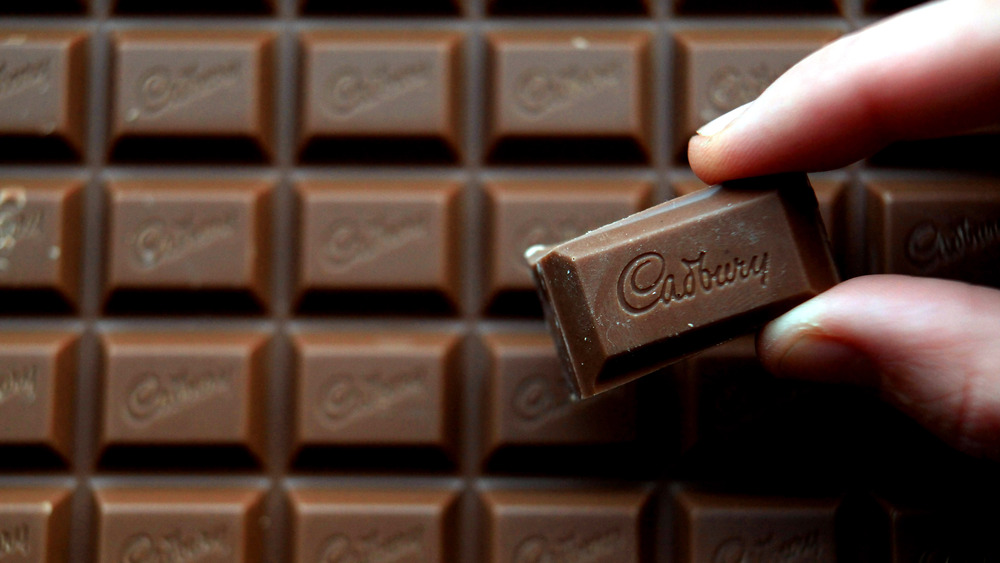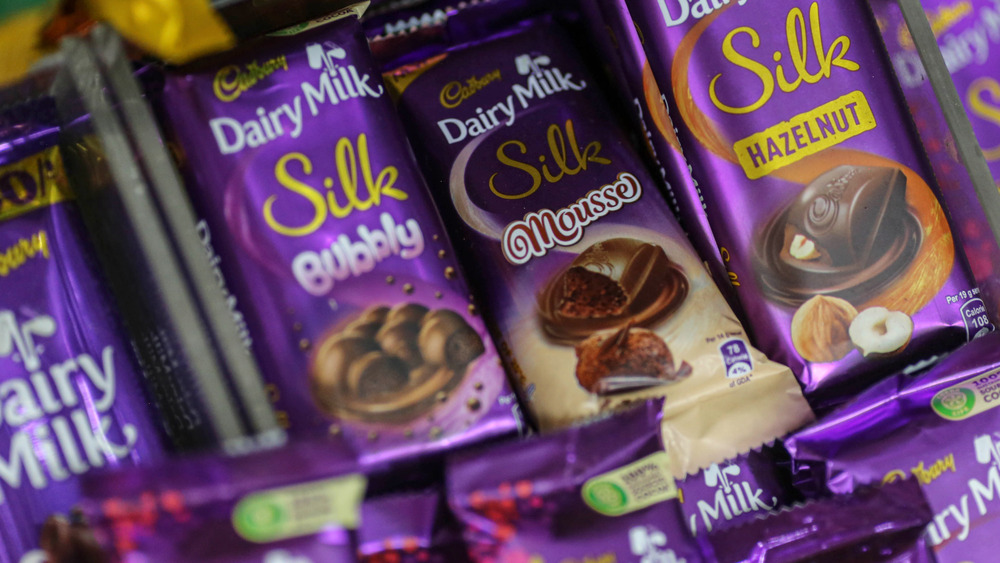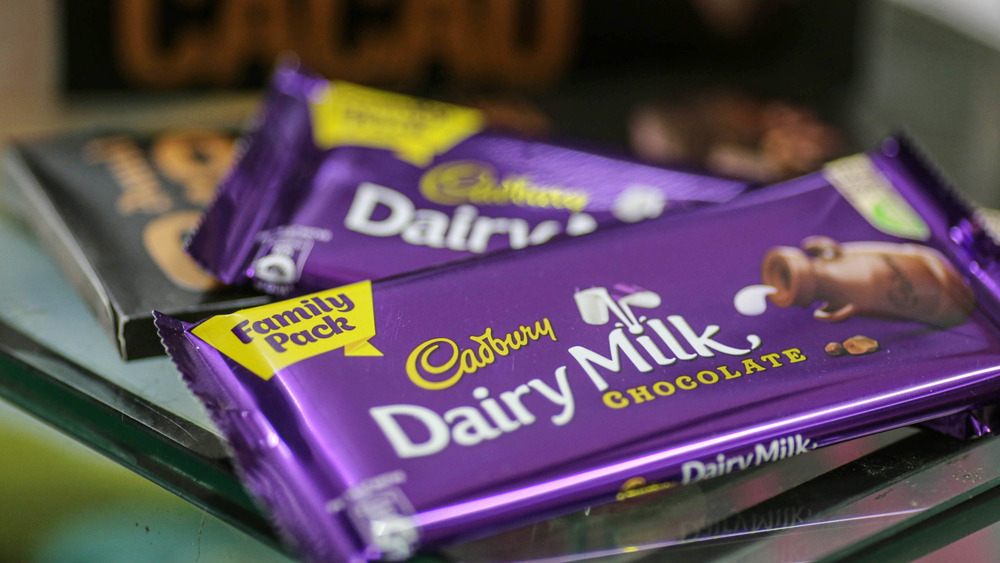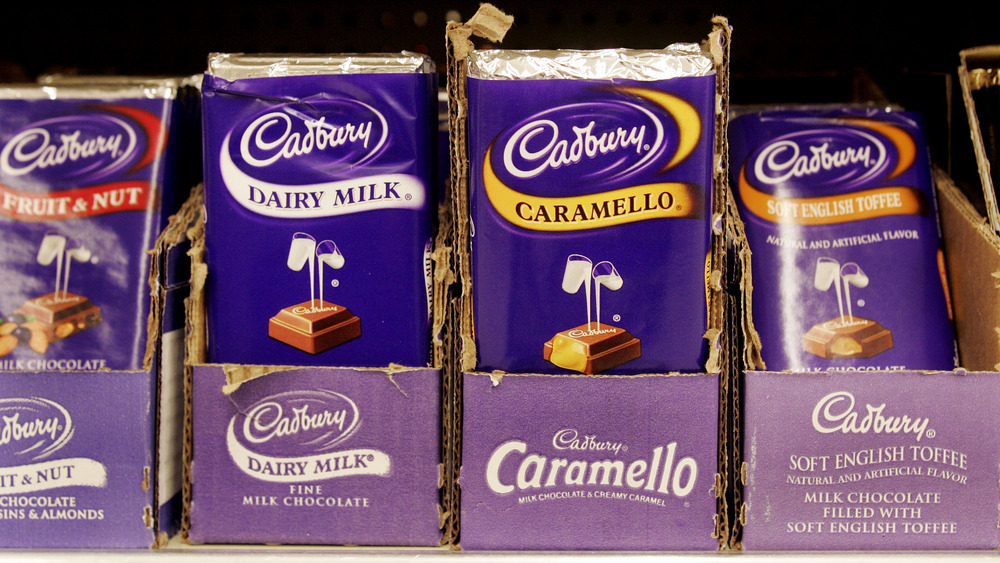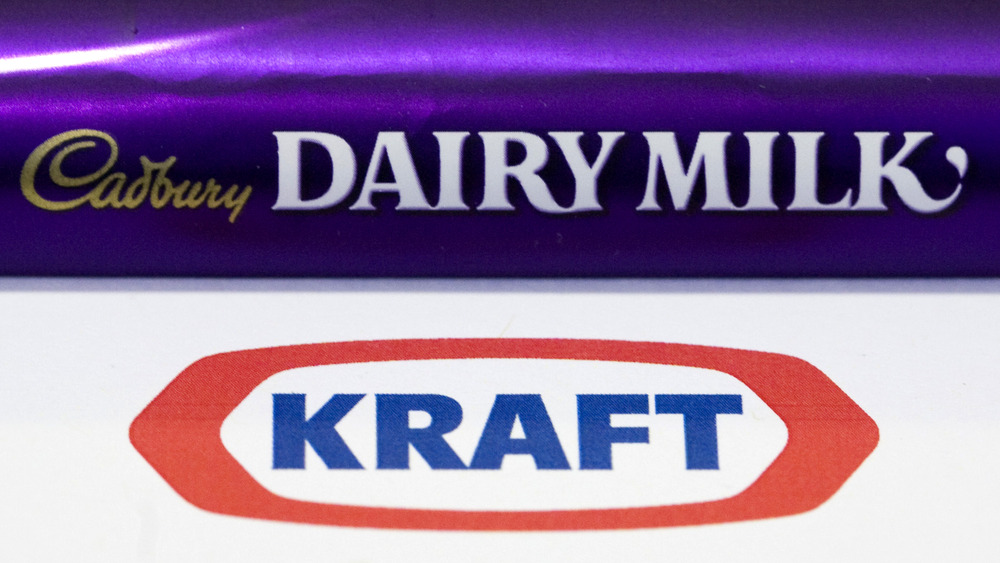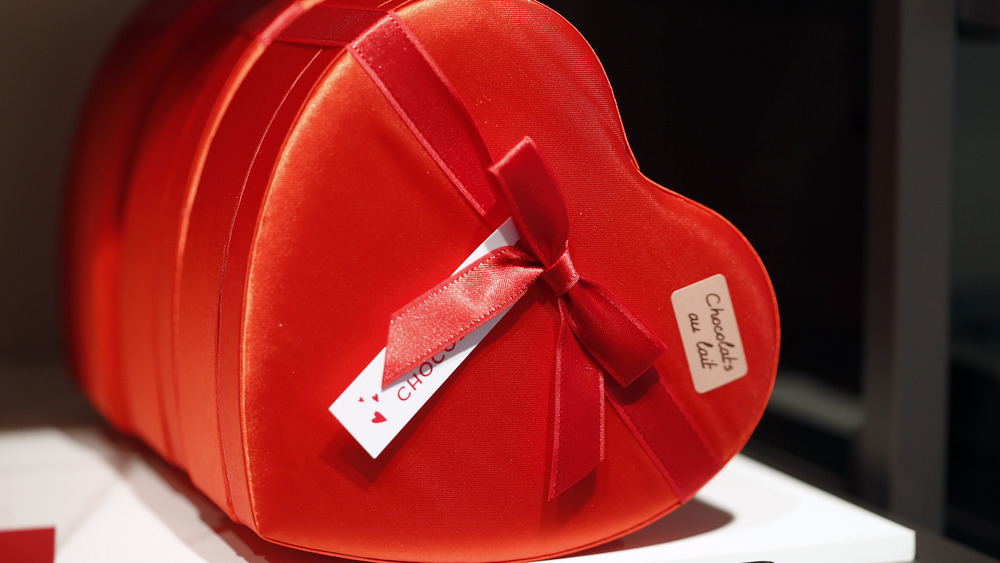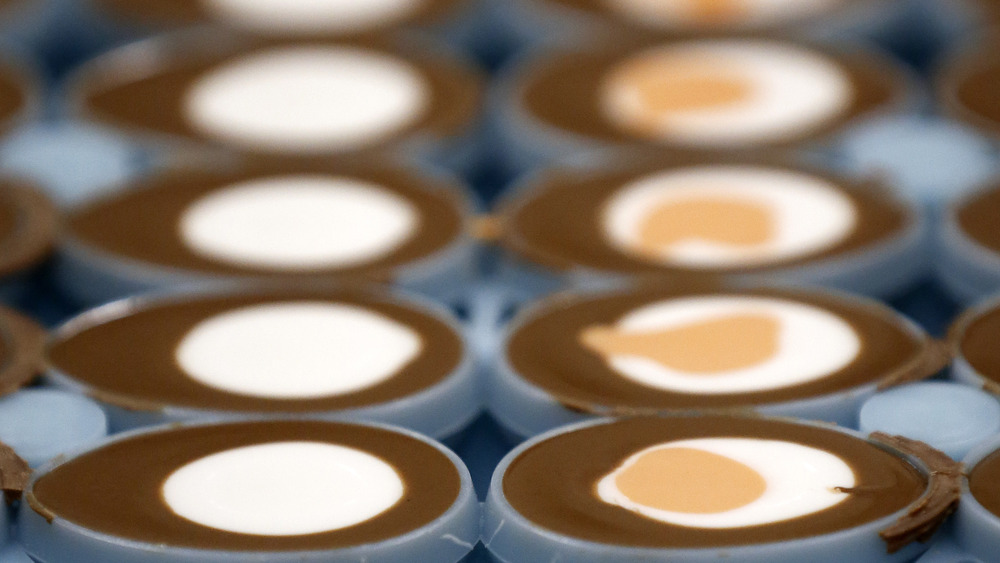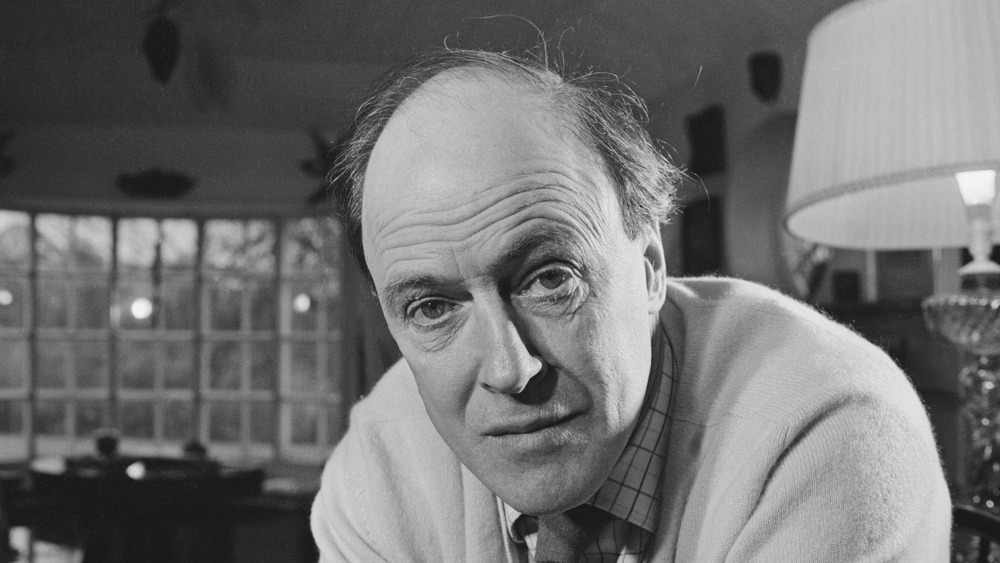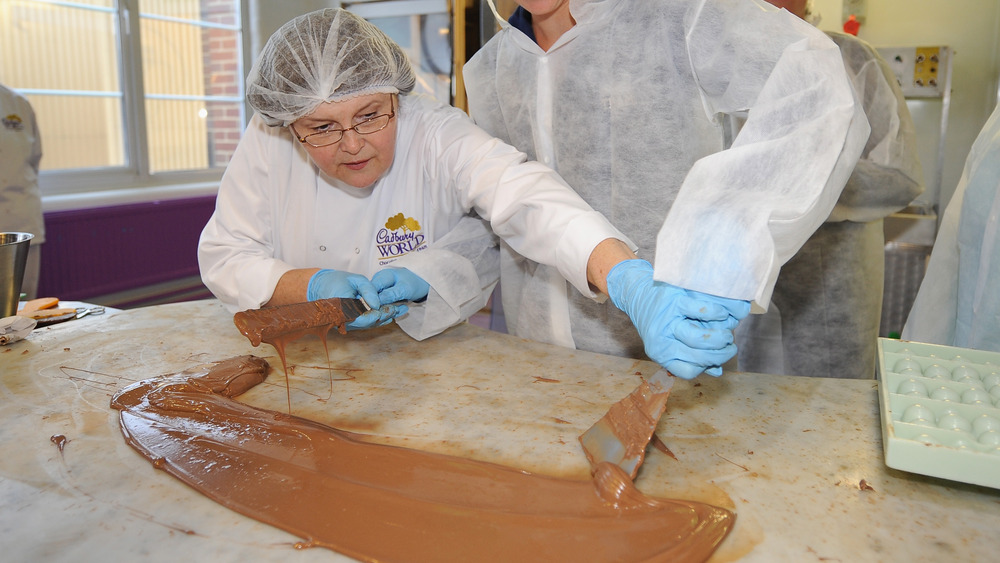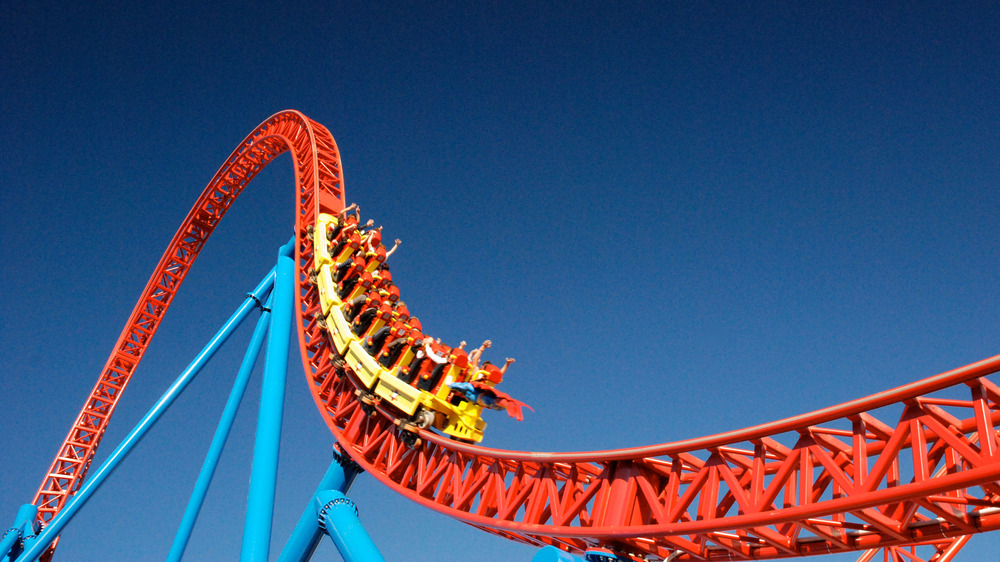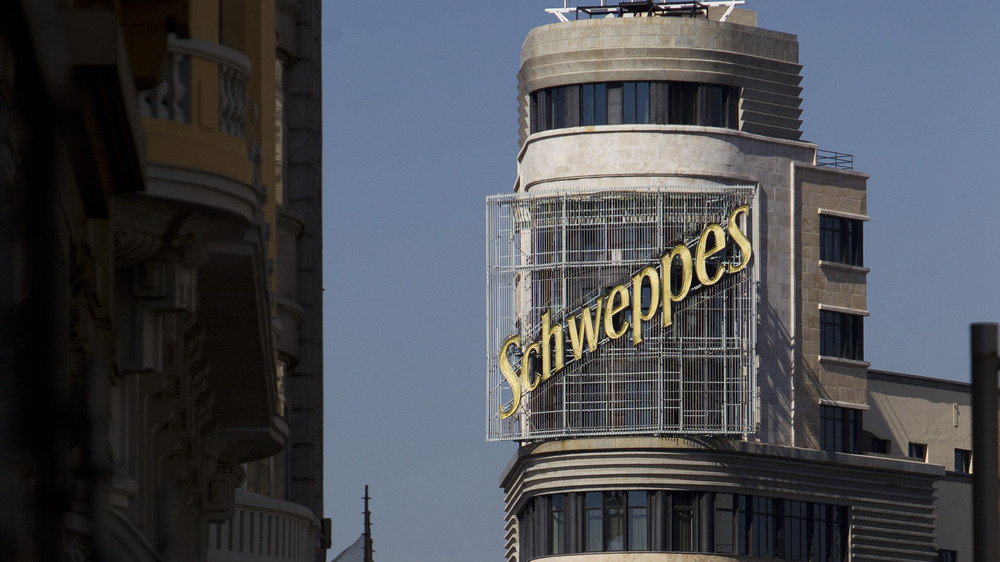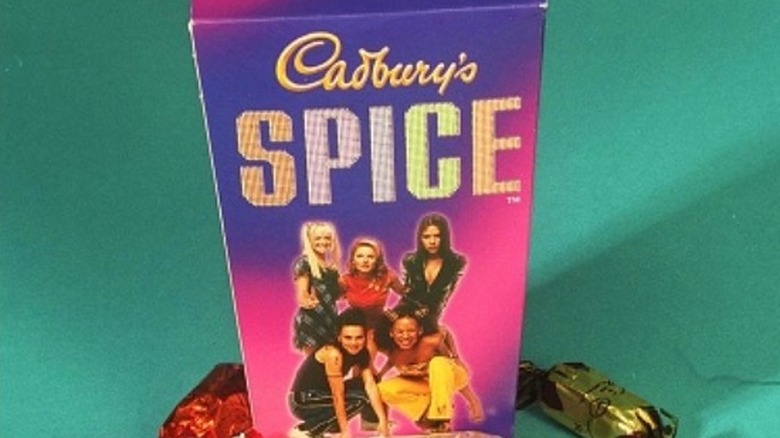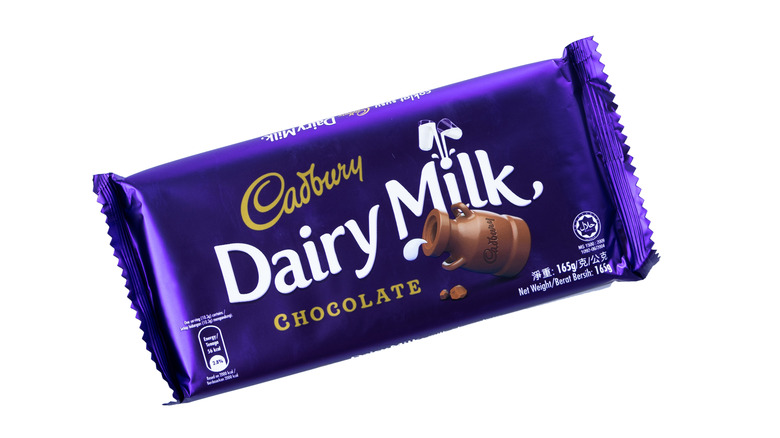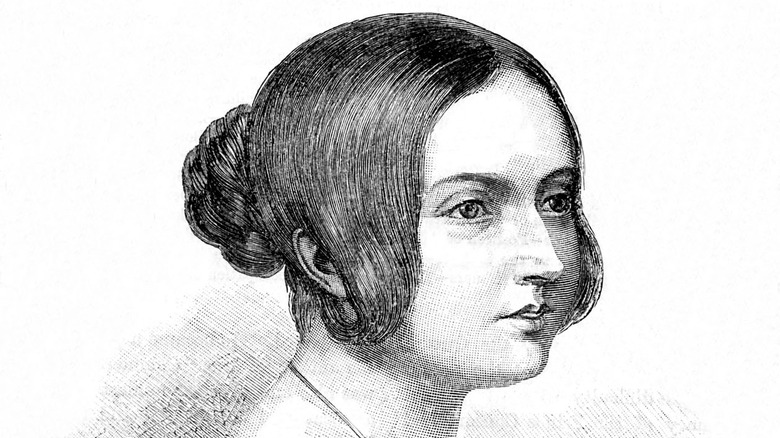Cadbury Chocolate: 13 Sweet Facts About The Candy Company
As one of the largest chocolate brands in the world, Cadbury has dominated international candy sales for years since its founding way back in 1824 (via Cadbury). Through a series of twists and turns, this food company with U.K. roots took the world by storm and transformed chocolate as we know it. It's almost impossible to think of Easter baskets without some delicious Cadbury chocolate inside. Through their relentless marketing and high-quality products, this goliath of a brand has truly established itself as a leader in the industry and keeps surprising us every day.
Over the course of the company's illustrious history, Cadbury has inspired classic literature, left an enduring mark on holidays (not just Easter), and even became a favorite of the royal family. Considering how popular the brand is, it's unlikely to go anywhere any time soon, which means it will only add to this fascinating, centuries-long legacy. Read on for some interesting facts you may not know about Cadbury chocolate.
John Cadbury sold chocolate because of the temperance movement
While we might think of Cadbury as a fanciful candy company, its origins have a much stauncher history. According to Culture Trip, John Cadbury, a teetotaling Quaker, started selling drinking chocolate, tea, cocoa, and coffee as he rallied against alcohol, which he saw as a detriment to society.
Cadbury personally believed that alcohol directly led to poverty and, thanks to his Quaker worldview, felt that all people should get treated with dignity and respect regardless of their station in life (via Chocolatour). The same views that drove him to serve drinking chocolate as an alternative to alcohol prompted his family members and business successors to build low-cost, good quality homes in the greater Birmingham area, all to house workers at the growing Cadbury operation. These values carried the chocolate company forward over the years and helped lay the foundation for this brand that eventually came to dominate the international candy market.
Cadbury is the most popular chocolate in the world
If you love the taste of Cadbury, you find yourself in the majority of chocolate fans. According to Candy Industry, 78 countries rank Cadbury as their preferred chocolate, including locales like India, the United Arab Emirates, and South Africa. In addition to coming in as the top internationally-loved chocolate bar, Cadbury also offers up one of the world's favorite chocolate bars — the Dairy Milk bar. The Cadbury Caramilk ranks a bit lower in the overall global list as the top chocolate bar in ten countries.
This world domination of chocolate comes as no surprise for fans of the candy. According to The Grocer, the brand ranks as Britain's fastest-growing brand, partially thanks to everyone indulging in some extra chocolates they sit at home and wait out the pandemic (via The Guardian). Only time can tell what happens next for this megalith of a brand, but with some luck, we should continue enjoying Cadbury chocolate internationally for a good long while.
Cadbury's discontinued products still inspire fans
Like many other time-tested brands, Cadbury has racked up a solid amount of fans over its years of operation. While these fans vocally rallied around their favorite products, Cadbury had other plans. Like so many other food brands, Cadbury has the tendency to rip our favorite foods right out of our lives just as we got attached to them. With a history that stretches back almost 200 years, it's only natural that a good handful of discontinued products developed a cult following like no other.
According to The Sun, white chocolate fans had field days when Cadbury rolled out their now-discontinued Flake Snow, a chocolate bar filled with white chocolate. Meanwhile, the Wispa Mint earned its place in the pantheon of great Cadbury chocolates thanks to its aerated chocolate coated with a thin mint layer, despite vanishing years ago. On the other end of the Cadbury spectrum lies the discontinued white chocolate Dream bar, the first white chocolate treat that Cadbury introduced to the world (via Delish).
As the brand continues forward, we one day have to come to terms that our favorite chocolates might not survive the march of time. In the meantime, we need to celebrate the chocolate bars that have fallen and enjoy the fantastic quality of Cadbury that keeps fans loving candy that has disappeared from store shelves.
Cadbury is actually owned by Kraft
While most of us likely have a strong mental image of Cadbury associated with England and the European chocolate tradition, many chocolate fans who don't follow business news might feel shocked to learn that Kraft currently owns the brand. According to The New York Times, Kraft bought Cadbury for $19 billion after a bidding war with Hershey chocolate that left Cadbury utterly demoralized. The company ended up getting bought for less than their asking price. The idea that a quintessentially British institution was bought out by a multinational conglomerate like Kraft sent shockwaves through the British collective consciousness. Protests erupted against the acquisition, with many wanting Cadbury to maintain their English sovereignty.
Kraft's purchase of Cadbury led to the UK passage of new laws aimed at controlling foreign takeovers of local business (via Bloomberg). Yet, the financial changes after the takeover complicate the narrative for many. Those who held onto their Cadbury stocks before the Kraft buyouts now have seen a 450 percent increase in returns, proving that from a financial standpoint, the company has gotten stronger. Only time can tell what happens to the company next, but as history has proven, this British institution can continue supplying the world with breathtaking chocolates, no matter the obstacle.
Cadbury invented the heart-shaped chocolate box
When you need to woo your sweetheart, nothing does the trick like a heart-shaped box of Valentine's Day chocolates. As it turns out, we have Cadbury to thank for this gesture that has since wormed its way into the public consciousness as one of the ultimate romantic moves.
According to USA Today, John Cadbury's sons began selling the first heart-shaped boxes of chocolate after they began managing the family business in 1861. If you assumed the packaging revolved around a romantic holiday, you would be right! In order to use up excess cocoa butter leftover from their drinking chocolate, the brothers decided to whip up chocolate morsels perfect for sharing. The first heart-shaped boxes made their appearance in 1868 for Valentine's Day. The boxes featured now-classic imagery of cupids, hearts, roses, and other sentimental Victorian imagery that could tug at the heartstrings of even the hardest-bitten recipient. It was certainly a far sight better than receiving a dreaded "vinegar Valentines" card.
Crowds instantly fell in love with this packaging and these boxes have stuck around ever since as a Valentine's Day essential. Next time you score one of these essential romantic boxes of chocolate, you can always thank Cadbury for making these heart-shaped packages a Valentine's Day standard. While the packaging has evolved over time, nothing can beat this iconic form.
Cadbury didn't invent the chocolate Easter egg, but did make it common
As Easter rolls around, nothing strikes up the feeling of the holiday like digging into a bag of chocolate eggs, especially the ubiquitous Cadbury Creme Egg. While this candy has graced baskets for generations, we have Cadbury to thank for the continuing popularity of this candy style. According to the UK Companies House, the first chocolate eggs got whipped up by independent chocolatiers in either Germany or France in the early 19th century. However, the first mass-produced chocolate egg popped up in England in 1873, made by J.S. Fry & Sons Limited. Joseph Fry, another Quaker, ran a competing chocolate company against the Cadbury family but couldn't quite hold a candle to Cadbury's operations.
Cadbury, who started making their own chocolate eggs in 1875, found the perfect way to package their chocolate eggs with colorful foil, making them the preferred chocolate eggs in England. These candies overshadowed Fry's chocolate eggs and eventually became synonymous with Easter. This Cadbury chocolate continues to dominate the market, just as it did when it entered the candy scene almost 150 years ago.
Cadbury helped inspire Charlie and the Chocolate Factory
Anyone who has read Charlie and the Chocolate Factory could only dream of falling into a world filled with the best candy a child could imagine. What if a chocolate factory like this actually existed and made the best chocolate you ever tasted? For Roald Dahl, this was Cadbury.
According to Biography, Dahl started attending Repton School in 1929. As a nice perk, Cadbury would test their latest creations out on the student body, sending free samples to the students. Staring at the purposefully nondescript packaging, Dahl imagined that Cadbury had secret candy creation rooms complete with men and women dressed in white, concocting new confections and experimenting to invent the next big candy. He even imagined himself as an inventor working in one of these secret rooms and rushing to Mr. Cadbury himself when he discovered the next big candy recipe.
Years later, Dahl started turning his childhood daydreams into books. His days testing Cadbury chocolate at Repton School led him to write a book that eventually turned into Charlie and the Chocolate Factory (via BBC). Without Cadbury, we very possibly wouldn't have this classic piece of literature that continues to capture the imagination of candy lovers of any age.
Cadbury in England tastes different than American Cadbury
If you ever traveled to the UK and got the chance to taste their Cadbury chocolate, you might notice a distinct difference compared to American Cadbury chocolate. According to Business Insider, this taste difference almost certainly comes down to the exact ingredients each chocolate uses, which aren't always the same. In America, the chocolate can only legally use cocoa butter to make up the chocolate bar's fat content, while the UK variant includes palm and shea oil. The creamy texture of the UK version has less of a cocoa taste compared to the US variant, while the UK version is said to have a lingering pleasant aftertaste. The US version lacks this aftertaste, leaving a slightly bitter flavor behind. It's a pretty subtle difference, however, as some tasters still can't pinpoint much of a difference between the two.
The taste and ingredient differences can partially stem back to the Kraft acquisition of the brand over a decade ago (via The New York Times). Before the buyout, Hershey's managed Cadbury US and used a different set of ingredients compared to the British original. As a result of the buyout, Cadbury UK and Cadbury US continue to use different products based on food standards laws found in each country, but luckily, the merger actually helped standardize both versions to a degree (via CNN). Next time you bite into a Cadbury bar, feel grateful for this taste improvement that stems from the Kraft buyout.
Cadbury has a theme park
Even if we can't go to Willy Wonka's chocolate factory in real life, we might just get the opportunity to visit the next best thing — Cadbury World. According to Cadbury World, the park combines educational resources with play zones, alongside the world's biggest Cadbury chocolate shop for an experience like no other. Visitors can learn about the chocolate-making experience through interactive displays, enjoy the Cadabra ride with its "Beanmobiles", and explore the Cadbury story through a variety of fun adventure zones.
If you seek some larger thrills, Cadbury still has you covered. The company runs an even larger theme park that features over 40 rides, including some truly massive roller coasters, a Madame Tussauds Wax Museum, sea park, Legoland, and much more (via Cadbury Merlin). For an exciting, chocolate-filled time, the company has something for anyone looking for fun, and thrill-seekers shouldn't pass up this theme park if they find themself in England anytime soon. Until Cadbury brings some of their attractions stateside, we just have to keep waiting for a chance to get the thrills packed into their signature theme park.
Cadbury used to own a soda company
If you love enjoying a can of Schweppes ginger ale from time to time, you might never believe this beverage could tie into a candy company. For many years, Cadbury owned Schweppes, Orangina, and a variety of other sodas (via Beverage Daily). The candy company sold these assets in Europe back in 2005 but maintained their soda holdings in the US, which at the time included 7UP, Sunkist, and Dr. Pepper. In 2007, these American sodas broke from the company, spinning off into their own commercial group, rather than waiting to get sold to a competitor (via CSP Daily News). Cadbury's grip on the Australian soda scene came crumbling down next, as the candy company lost control of its regional assets in 2009 (via Food Ingredients 1st).
This confection empire once held a grip on sodas throughout the world thanks to their control of the Schweppes group. As times changed, the company had to find profits, leading to the sales of their sodas, and eventually their brand to Kraft. While we might not get a chance to enjoy their pre-Kraft products anymore, we can still enjoy the tempting flavors and textures wrapped up in each Cadbury chocolate.
There were once Spice Girls Cadbury chocolate bars
The '60s had the Rolling Stones, the '70s had the Beatles, and the '80s had Guns N' Roses. As for the '90s, this is a decade that the Spice Girls had firmly in its clasp. Amid topping global music charts, Cadbury launched the Spice Girls Dairy Milk bar. These featured a range of 10 wrappers, the inside of each with its own set of "Spice Facts" about the Spice Girl shown on the outside. For instance, besides her nickname, date of birth, and star sign, Emma, aka Baby Spice's "Spice Facts" noted that she "washes her hair every day, has a cat called Fluffy, loves sweet things!"
The U.K. version was distributed from 1997 to 1998 with English text, while the Canadian version featured both English and French text. For Lester Hughes, these limited edition chocolate bars have lasted 20 years. Per The Daily Post, besides the Spice Girls chocolate bars, the limited edition chocolate enthusiast's collection dates as far back as 25 years and contains a Westlife range, along with Milky Ways and Kit Kat bars that have five fingers instead of four.
Cadbury and Nestlé went to court over the color purple
Cadbury and Nestlé remain fierce chocolate competitors to this day, but did you know that the companies' competition once went as far as the courtroom? In October 2004, Cadbury applied to trademark the color purple associated with its products. However, Nestlé countered the application on the basis that colors should not be trademarked for the sake of "commercial advantage."
The legal battle, which started in 2008, continued until 2012 when Judge Colin Birss ruled in Cadbury's favor. The judge reportedly stated that the color purple is not only "distinctive of Cadbury for milk chocolate," but that this had been the case since 1914. Just as all was supposedly said and done, Nestlé hauled Cadbury back to the Court of Appeal with an application against the ruling. Nestlé nabbed the victory this time, reportedly because Cadbury's trademark application had neither fulfilled trademark registration requirements nor provided the "required clarity, precision, self-containment, durability, and objectivity to qualify for registration."
Queen Victoria was a fan of Cadbury chocolate
While Queen Elizabeth II was getting secret Cadbury chocolate bars, it seems she may have inherited her penchant for sweet treats from Queen Victoria. Cadbury makes a small batch of chocolates that are delivered to the Royal Family just in time for Christmas every year. Originally made to Queen Victoria's tastes using reserved equipment, these chocolates are wrapped in a gold foil that is covered by a red wrapper clad with a royal crest stamp and the words "By Appointment to HM The Queen."
In 2021, a chocolate bar dating back 121 years had been found in an English manor. The chocolate bar, which was still in its original tin, had reportedly been given to Henry Edward Paston-Bedingfield by Queen Victoria during the Anglo-Boer War in South Africa. Although Quakers, Cadbury's then manufacturer, was against the War and thus refused to brand the tins, ended up branding just some chocolate bars after the Queen's insistence.
